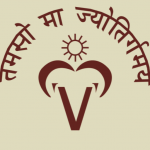
Vanamala Center for Art and Culture as a part of its Bharatiya Samskriti Darshana-20 series, organized an online study circle by the eminent Musician Musicologist Dr. B.M.Sundaram for six days, from 14th to 19th May 2022. It was a one-hour session, where Sundaram Sir spoke on various unknown aspects and facts on the life and contribution of Saint Tyagaraja. The clarifications and discussions which took place at the end of each session was even more interesting, showing the enthusiastic participation of the scholars present.
The first day was a grand start by Sundaram Sir which was about the year and place of birth of Tyagaraja – the differences found in different sources. The fact that Tyagaraja was born in Tiruvayyaru was revealed by Sir who personally visited that house with the help of the former’s grand-daughter-in-law. He said that the place was later made as a Vedic pāṭaśala. Sir gave many examples from Tyagaraja’s kṛti-s themselves to demonstrate this fact, i.e., the birth-place of Tyagaraja as Tiruvayyaru.
Another interesting factor in this lecture series, was the origin of Tyagaraja Ārādhana festival conducted in Tiruvayyaru. Sir explained the detailed history of the festival and how many music scholars tried hard to conduct the same. He also mentioned that the practice of singing pañca-ratna kṛti-s was a later addition and the name “ghana-rāga” for this set, was inappropriate. Swara-singing for these kṛti-s were also a later addition. In the kriti Sadhinchana, after every charana, pallavi has to be repeated not the phrase ‘samayiniki’ which is commonly rendered in the present days. He said that the notations for these kṛti-s differ from the original source and that “kanakanarucira” had only pallavi and one caraṇa and the rest was composed and included later.
Padaccheda was also an interesting aspect where Sundaram Sir strongly recommended that every musician had to know the proper pronunciation with meaning and then render the particular kṛti, including the pañca-ratna kṛti-s. He stressed on the importance of breath control in-between two words and maintaining the sāhitya bhāva without breaking a word.
He said that the aspect of neraval in Karnāṭak Music came from dance where they had to repeat the same sāhitya many times to show the sancāri bhāva. He also gave information on what type of compositions can be chosen for bharatanāṭyam. Not just the viḷamba-laya but the sāhitya must have sṛṅgāra bhāva or any other aspect of portrayal to be chosen for dance, he added.
Dr. B.M.Sundaram Sir, who gave these lectures, himself became a great role-model to all the scholars and researchers. His patience in explaining, listening to the questions and responding to it; his humble nature in respecting the art, artists and researchers; adaptability, where he learned to give lectures online at that ripe age of 80; the nature of giving all the information that he collected. He made the sessions so interactive and every musician, researcher in the audience thoroughly enjoyed his lectures. I think, as researchers and musicians, each and every one has a responsibility in carrying-forward this tradition to the future generations there-by retaining and promoting the antiquity of Karnāṭak Music History.

Here are a few pictures of the lectures and valuable response from the attendees.










Leave a Reply